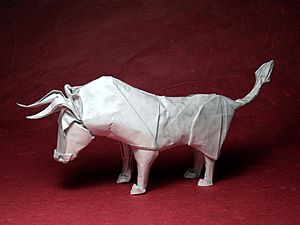Akira Yoshizawa facts for kids
Quick facts for kids
Akira Yoshizawa
|
|
|---|---|
| 吉澤 章 | |
 |
|
| Born |
Akira Yoshizawa
14 March 1911 Kaminokawa, Japan
|
| Died | 14 March 2005 (aged 94) |
| Nationality | Japanese |
| Occupation | Artist, Author |
| Known for | Origami |
| Awards | Order of the Rising Sun |
Akira Yoshizawa (吉澤 章 Yoshizawa Akira; born March 14, 1911 – died March 14, 2005) was a Japanese origami artist. Many people consider him the greatest origami master of all time. He helped turn origami from a simple craft into a respected art form.
Yoshizawa once estimated that he created over 50,000 origami models. Only a few hundred of these designs were shown in his 18 books. He traveled the world, sharing Japanese culture through his art. In 1983, the Emperor Hirohito gave him the Order of the Rising Sun. This is one of the highest honors in Japan.
His Life Story
Akira Yoshizawa was born on March 14, 1911, in Kaminokawa, Japan. His family were dairy farmers. As a child, he loved teaching himself origami.
When he was 13, he moved to Tokyo to work in a factory. In his early 20s, his love for origami grew again. He was promoted to a job where he drew detailed plans and taught geometry to younger workers. Yoshizawa used traditional origami to help explain tricky geometry problems.
In 1937, he left his factory job to focus on origami full-time. For the next 20 years, he lived in great poverty. He earned money by selling tsukudani, a Japanese preserved food, door-to-door.
During World War II, Akira Yoshizawa served in the army medical team in Hong Kong. He made origami models to cheer up sick patients. He eventually became ill himself and was sent back to Japan.
His origami work was so creative that it was included in a 1944 book called Origami Shuko. But his career really took off in 1952. He created 12 zodiac signs for the magazine Asahi Graph.
In 1954, his first book, Atarashii Origami Geijutsu (New Origami Art), was published. In this book, he created the Yoshizawa–Randlett system. This is a special system of symbols, arrows, and diagrams for origami folds. It is now used by most paper folders around the world. This book helped Yoshizawa escape poverty. Soon after, in 1954, he started the International Origami Centre in Tokyo. He was 43 years old at the time.
His first show outside Japan was in October 1955. It was held at the Stedelijk Museum in Amsterdam. Yoshizawa often lent his origami models for shows around the world. He never sold his origami figures. Instead, he gave them as gifts or let groups borrow them for exhibitions.
His second wife, Kiyo Yoshizawa, helped manage his work. She also taught origami to patients. Akira Yoshizawa passed away on his 94th birthday, March 14, 2005, from pneumonia.
His Special Techniques
Akira Yoshizawa invented many origami methods. One of his most important ideas was wet-folding. This technique involves making the paper slightly wet before folding it.
Wet-folding makes the paper easier to shape. This helps create finished origami models that look rounder and more like sculptures. Being able to make origami look more realistic was a big step forward. It helped turn paper folding from a simple craft into a true art form.
Wet-folding works best with thicker paper. Regular origami paper is very thin and can tear easily when wet. Yoshizawa believed the process of folding was the most important part. He often said, "When you fold, the ritual and the act of creation is more important than the final result. When your hands are busy your heart is serene."
Later Years
In March 1998, Yoshizawa was asked to show his origami at the Carrousel du Louvre in Paris. When he was younger, he sometimes didn't get along with other origami artists. Many of his designs were drawn out by others, which used to make him upset. But as he got older, he enjoyed being with his fellow artists.
Akira Yoshizawa died on March 14, 2005, in a hospital in Tokyo. He passed away from problems related to pneumonia on his 94th birthday.
Books
- Atarashii Origami Geijutsu, Origami Geijutsu-Sha 1954
- Origami Reader I, Ryokuchi-Sha 1957
- Dokuhon, Vol.1 (Origami Tokuhon), 1973, ISBN: 4-8216-0408-6
- Sosaku Origami (Creative Origami), Nippon Hoso Kyokai 1984, ISBN: 4-14-031028-6
- Dokuhon, Vol.2 (Origami Tokuhon), 1986
- Origami Dokuhon II (Origami Reader II), Kamakura Shobo 1986, ISBN: 4-308-00400-4
- Origami: Living Nature, 1996, ISBN: 9784916096319
See also
 In Spanish: Akira Yoshizawa para niños
In Spanish: Akira Yoshizawa para niños


